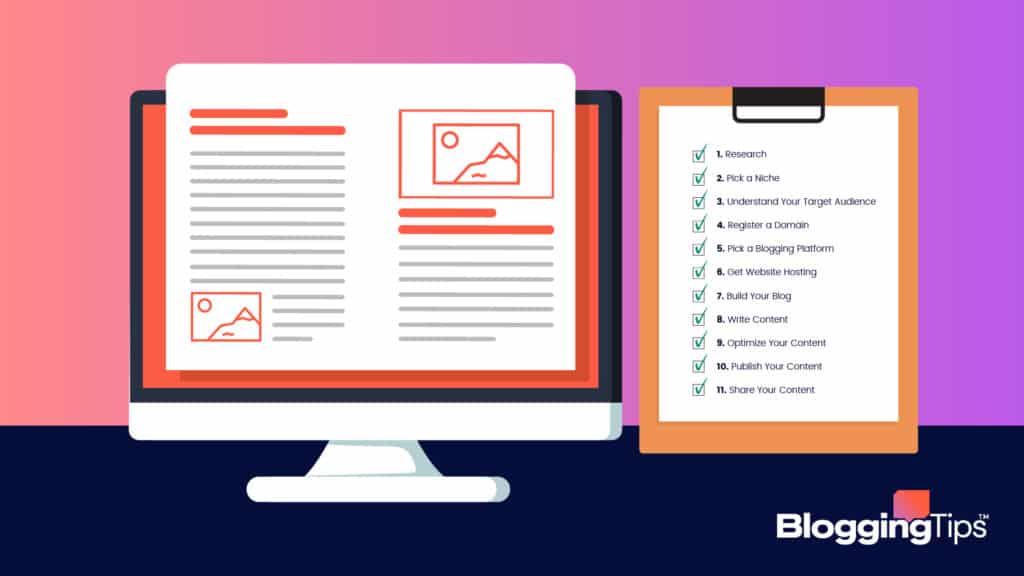Before launching a blog, you should decide on a blogging process to follow.
Sticking with a clear outline of steps helps you stay on track and avoid overlooking anything.
For the first blog that I created, I rushed the process and soon abandoned the project.
I later developed a series of steps to keep from repeating the same mistakes.
Use the following guide to explore the steps needed for a successful blogging process.
Contents
Basics of a Successful Blogging Process
The blogging process includes two main stages—creating a blog and creating blog posts.
Here’s a quick look at both aspects of blogging.

Blog Process: Starting a Blog
The first step in the blogging process is creating and launching your blog.
At the most basic level, a blog is a webpage that provides access to your blog posts.
The steps involved in creating the blog include:
- Research
- Pick a niche
- Understand your target audience
- Register a domain
- Pick a blogging platform
- Get website hosting
- Build your blog
- Write content
- Optimize your content
- Publish your content
- Share your content
The work does not stop after sharing your content.
You also need to continue to produce new content, interact with your audience, and follow trends.
Blogging Process: Creating Blog Posts
After creating a blog, you can start writing and publishing blog posts that you will host on your blog.
There are three main steps in creating blog posts:
- Pre-Writing
- Drafting
- Revising
Following these steps helps you optimize your content before sharing it with the public.
Repeatable Blogging Process: Using an Editorial Calendar
Growing a successful blog requires you to continually repeat the blogging process.
Using an editorial calendar helps you consistently create new content.
What Are the 11 Steps in Creating a Blog?
Here is a breakdown of each of the 11 steps needed to create a successful blog.

1. Research All Your Options
Research the market or industry that you plan on targeting with your blog.
Make sure that there is enough interest and demand for a new blog.
Some of the details that you need to research include:
- Your niche category
- Your target audience
- Your domain name
- Your blogging platform
- Your web hosting
- Skipping any of these steps may severely limit your chances of success.
2. Select a Niche Category
One of the most important decisions is selecting the niche category that you want to write about.
A niche category allows you to focus on a smaller audience with more targeted content.
You can create a stronger connection and a more loyal fanbase.
A niche market also makes it easier to compete with larger, more established brands.
These niche areas are sub-categories of other industries.
For example, backyard vegetable gardening is a niche category within the gardening market.
Muscle building is a niche portion of the fitness industry.
3. Understand Your Target Audience
After choosing a niche, start researching your target audience.
Consider creating a persona of your ideal reader.
A persona includes a summary of key information related to the demographic that you want to target.
Some of the details to consider include:
- Age range
- Gender
- Hobbies and interests
- Geographic area
- Education level
- Income level
You should also find out which platforms they use and the websites they visit.
This information can help you find ideas for future blog posts and keep up with the latest trends in your niche market.
4. Register a Domain Name
Choose a domain name that makes sense for your niche market but still allows room for growth.
For example, you may not want to call a blog about backyard gardening “backyard gardening,” as you may eventually want to write about indoor gardening or greenhouse gardening.
You should also search for the domain name to make sure that it is available.
5. Pick a Blogging Platform
Unless you plan to hire a web design agency to handle your website, you will need to pick a blogging platform for building your site and posting your blogs.
WordPress stands out as the top choice for most entrepreneurs and bloggers, as it is user-friendly and free.
You can install WordPress on any website hosting account and start building a website within minutes.
6. Get Website Hosting
Most bloggers start with a shared hosting plan, which is the most affordable way to rent server space for hosting a website.
A shared hosting plan can handle up to 3,000 visitors daily.
If you expect more traffic, you may want to switch to dedicated server hosting.
7. Design and Build Your Blog
After signing up with a hosting account, you can install WordPress and start building your blog.
WordPress is also a great choice due to the variety of tutorials you can find online that walk you through building a blog.
You can start with a free theme or spend money on a premium theme.
Either way, take the time to edit the layout and colors to make your design original and match the image that you want to present.
8. Write Engaging Content
With your blog setup, you can now start creating content.
Take the time to perform research and write drafts instead of rushing to publish new posts as quickly as possible.
When it comes to growing a successful blog, quality is much more important compared to quantity.
9. Optimize Your Content
Always optimize your content to make sure that it follows the current best practices for search engine optimization (SEO).
You should focus your content on a specific keyword without stuffing the phrase into the content too much.
You can also use a wide range of variations of the keyword.
10. Publish Your Content
Consider scheduling the publication of your content using an editorial calendar.
You can stick to a consistent release schedule, which helps your audience know when to expect new content.
11. Share Your Content
You cannot build your audience if they cannot find your content.
Share your content using social media profiles created for your blog.
Unless you plan on building a personal brand for your blog, you should create separate social media accounts for your new blogging business.
The 3 Steps of the Writing Process
Bloggers publish over 7.5 million new blog posts each day.
Getting people to enjoy your blog requires quality content, which involves multiple steps.

1. Pre-Writing
Pre-writing includes the research and planning for your blog post.
Search for the topic that you plan to write about.
Create an outline of the post using an online tool, such as Google Docs or Frase.io.
You should create a clear outline before you write the initial draft of your blog post.
An outline helps keep the blog post on point.
It is especially helpful if you plan to outsource the writing.
2. Drafting
Drafting involves creating an initial draft of your blog post based on the outline created in the previous step.
Focus on providing helpful, accurate information with no filler content.
You should also consider reaching a specific word count.
Individual blog posts range in length from 300 to 5,000 or more words.
A word count of 2,000 words is considered a good median length for most topics.
3. Revising
Use Grammarly and Hemingway Editor to revise your content and correct any grammatical mistakes.
You should also proofread your content to make sure that it flows well.
A Repeatable Blogging Process Proven to Work
You cannot sporadically release blog posts and hope to grow the size of your audience.
You need to repeat the process by releasing new blog posts consistently.
Use the following proven strategy to repeatedly write, optimize, and publish quality content.

1. Plan and Research Your Blog Post
Use Google Sheets, Google Keyword Planner, and Google Trends to plan and research your blog posts.
You can use the Keyword Planner and Google Trends to find out what people in your niche market are searching for online.
Use trending topics and search terms to create a list of potential topics for your blog posts.
You can use Google Sheets to create your lists and share them with others.
After choosing a topic for a blog post, research it.
Read the top posts on the topic while creating a list of potential sub-headers and questions to ask in your blog post.
2. Create an Outline for the Post Using Frase.io
You can now outline your blog post using Frase.io, which is an AI content optimization tool that makes it easier to develop optimized content.
You can use Frase.io whether you work alone or with a team.
However, Frase is great for sharing content outlines with others, such as when assigning a blog post to a writer.
3. Write the Initial Draft
Write the initial draft of your blog post in Google Docs.
As with Frase, Google Docs makes it easy to share content.
You can let others view and edit your Google documents.
You can also access your files from any internet-connected computer without needing to install software, such as Microsoft Word.
4. Optimize the Post
Use Surfer SEO, Clearscope, or MarketMuse to optimize your post.
These online tools help ensure that your content includes relevant keyword phrases and complies with the best SEO practices.
5. Edit the Post
Use the Hemingway Editor and Grammarly apps to proofread and edit your post.
Grammarly helps catch grammar mistakes that Google Docs and other word processors may not catch.
Hemingway Editor is useful for making your content more readable.
You can avoid creating sentences that are too long or complex.
6. Import the Post to WordPress
Use the Wordable WordPress Plugin to import your post to WordPress.
You can import your draft from Google Docs directly into a new blog post through your WordPress dashboard.
7. Publish the Post for the World to See
After importing and formatting the post, publish it.
WordPress allows you to publish the post instantly or set a publication date.
You may want to set a publication date if you intend on releasing content on a set schedule.
8. Share the Post Using Online Tools
Use online tools such as Buffer to share the post.
You need to ensure that your post reaches as many people as possible if you hope to grow your readership.
Buffer allows you to schedule social media posts.
You can time the release of promotional posts to coincide with the publication of your blog posts.
9. Track the Post’s Progress
Use Google Analytics to track the post’s progress.
Pay attention to the number of visitors and bounce rates.
After you have released multiple blog posts, start tracking which type of content performs best.
Try to determine what makes some of your blog posts more successful compared to others and start emulating what you uncover.
For example, you may find that posts related to a specific topic receive the most visitors and shares.
Creating more content related to the same topic may help you grow your audience.
What Makes a Blog Successful?

Successful blogs provide readers with consistently engaging content.
They offer helpful information and release new posts on a predictable schedule.
Some of the most successful blogs are lifestyle blogs.
Lifestyle blogs cover a wide range of niche categories, from fashion and travel to fitness and hobbies.
For example, Lifehacker receives millions of visitors each month due to the blog’s helpful articles on a variety of topics.
However, Lifehacker and other top blogs receive help from a long list of contributors.
Personal blogs run by an individual entrepreneur or small team typically succeed by cultivating a brand that connects with a niche audience.
For example, Mr. Money Mustache is one of the most popular blogs devoted to personal finance.
A former software engineer launched the blog in 2011 to help people retire early.
Why Do Most Blogs Fail?
Not all blogs succeed.
Here are some of the most common reasons why blogs fail:
- No clear strategy
- A lack of quality content
- Not focusing on a niche audience
- Inaccessible web design
- No search engine optimization
Blogs tend to fail when the creators fail to provide readers with something of value.
You also need to ensure that people can find your content, which involves sharing and SEO.
Related: More website mistakes to avoid while building a blog
Wrapping Up
Creating a successful blog does not typically happen overnight.
You need to put thought into your process and take the time to choose the right niche market.
After building a website, start researching the topics that your audience wants to know more about.
Create original content aimed at your niche audience.
Always review, revise, and optimize your content before publishing it.
In the end, launching and growing a successful blog requires a commitment.
You need to continue creating new content and continue paying attention to what works and what doesn’t.




